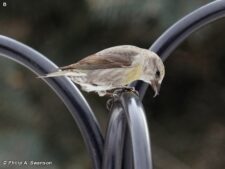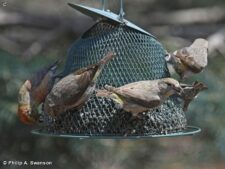
6.25 inches long. The distinguishing mark for the Red Crossbill is a large bill with crossed tips. The tail is short and forked. The male has a red head and body many times with much mottling. The female is a dull gray plumage with a dull yellow breast, rump, and crown. Juveniles resemble females but are more heavily streaked.
The Red Crossbill is an occasional winter visitor that does not show up every year. It can arrive as early as late October and may stay until late April. The Red Crossbill may be seen at the feeders at Neale Woods.
The Red Crossbill is often found in flocks and generally found in pine trees. They use their crossed bill to remove seeds from conifer cones. The Red Crossbill shows considerable size and vocal variation, and the split of the species into up to eight separate species has been discussed. The nomadic movements characteristic of Red Crossbills are driven by the variable nature of cone production over most of North America. The song is a series of two note phrases followed by a trilled warble. As mentioned above the calls vary by sub-species.
Disclaimer: The content of NatureSearch is provided by dedicated volunteer Naturalists of Fontenelle Forest who strive to provide the most accurate information available. Contributors of the images retain their copyrights. The point of contact for this page is: Phil Swanson.


